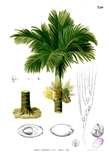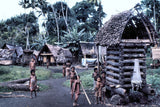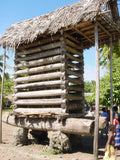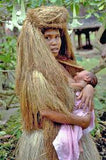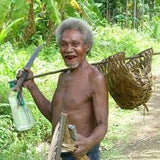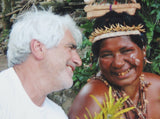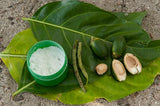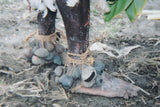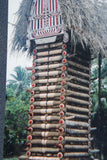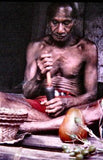MELANESIA MASSIM TROBRIANDS ISLAND (BETEL LIME) UNIQUE WOOD CONTAINER SET (WITH DELICATELY HAND CARVED POUNDER), PATINA ON UNIQUE FUNNY & INTERESTING UMBRELLA RECEPTACLE WHICH COMES WITH A NICELY HAND CARVED MORE RECENT POUNDER. No BP6
WOODEN LIME CONTAINER (UMBRELLA HANDLE) THAT ENDED UP MYSTERIOUSLY IN THESE REMOTE TROBRIAND ISLANDS & SHOWS PATINA NO LESS! WE COULD NOT RESIST BUYING IT FROM A NATIVE WITH THE POUNDER HE WAS USING IN IT, SHOWING AMUSING INGENUITY. THE OMBRELLA BASE & THE POUNDER (WITH VERY NICE HAND CARVED DETAILS) WERE USED TOGETHER BY THAT SAME TRIBAL MAN WHO WAS VERY PROUD OF THIS UNUSUAL CONTAINER SINCE NOONE ELSE HAD ONE LIKE IT IN THE VILLAGE. No BP6.
The lime pounders and containers of the Trobriand Islands are among the most collectible carvings in Oceania. Lime spatulas, pounder and receptacles are related to the betel nut chewing habit and are of great importance in the Massim area.
Please inspect photos carefully to be satisfied, pictures speak louder than words.
BP6 ‘s umbrella cup measures: 3 3/4", the pounder carved out of local wood is 9 ¼” long. On photo 11, you see the pounder next to a Trobriand spatula also available in our sales.
They are related to betel nut chewing, an activity that accompanies many social and ritualistic occasions.
The practice of betel nut chewing actually involves the chewing of three substances together: the nut of a palm (which purportedly tastes similar to nutmeg); the leaf, bean, or stem of the betel vine, which is a member of the pepper family; and hydrated or slaked lime (from burned seashells or coral or from mountain lime).
Betel chewing is part of working in the gardens, attending feasts, meeting friends, trade rituals, and making love for the people of East New Guinea and the Trobriands.
A traditional part of a man's personal paraphernalia in New Guinea and the Trobriands was his lime container and the spatula for betel chewing, a custom practiced on social and ritual occasions.
Three substances are actually chewed together: the nut of a palm, which has a hot, acrid taste similar to nutmeg; the leaf, bean, or stem of the betel vine, which is a member of the pepper family; and slaked lime made from burned sea shells or coral or from mountain lime and kept in this container while not in use. Once chewed, the mixture becomes a mild stimulant said to reduce hunger, pain, create a sense of well-being, and increase a person's capacity for work. Chewing betel nut makes people teeth turn red and eventually rot.
The Massim district from which these lime spatulas originate consists of the southeastern tip of New Guinea, the Louisade Archipelago, the D'Entrecasteaux Islands, and the Trobriand Islands. There is much trade between the islands; both ceremonial trading, called hula in which shell-disc necklaces and shell armbands are exchanged, and utilitarian, in which canoes, clay pots, wooden bowls, pigs, food, betel-nuts, and betel chewing utensils are traded. Betel chewing plays an important role in the hula. Lime spatulas are sometimes offered to get the trade partner to yield the desired hula item and the power of betel chewing is also used to influence trading.
All our collector and rare items come with pages and pages of research about provenance, and with history of the tribes and photos as well, depending on item and whenever possible. When shipping internationally, we group ship multiple purchases to save you money, and find the best rates available. If you have any questions or want to see research conducted on these pieces, let us know.










































